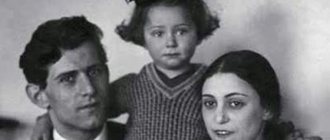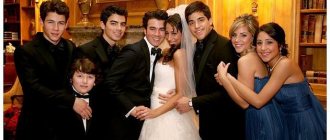“The beautiful Maya had a Marilyn Monroe type at that time... That famous shot where the wind from the underground ventilation lifts up the hem of her dress. And Vasya was all denim, super fashionable... It was the appearance of such a lovely couple that completely competed with the surrounding European landscape,” Evgeny Popov and Alexander Kabakov recall in their joint book. Maya Carmen, friend of Bella Akhmadulina, wife of the famous documentary filmmaker Roman Carmen, hero of Socialist Labor and personal friend of Brezhnev...
Two stars
Vasily Aksenov, Vasya, was also a star. Everyone read him, everyone talked about him, everyone wanted to be friends with him. And everyone somehow knew what he looked like, and unmistakably recognized him as a guy in faded jeans and a denim shirt, with denim-colored eyes and some kind of foreign mustache. And everyone knew that Aksenov was married. His wife, Kira, was marrying a young and poor doctor from the outback - if only she knew that Aksenov would pull out his “Star Ticket” and become the first writer of his generation! One day, tired of the endless fuss with the children, Kira came to her husband at the House of Creativity. Maya Carmen also arrived there. Once upon a time, several years before this evening at the House of Creativity, Aksenov and Roman Karmen accidentally ended up on the same train. Aksenov was “under the bank” and asked:
“They say you have a pretty wife?”
Carmen replied dryly that he liked his wife.
Maya Carmen: biography
Maya Afanasyevna Zmeul, better known as Maya Carmen, was born in June 1930 in Moscow, in the family of a civil war hero, Soviet historian Afanasy Andreevich Zmeul. A few years after Maya’s birth, her father headed the All-Union Academy of Foreign Trade. During the Great Patriotic War, he went to the front and was an agitator in the propaganda department of the Political Directorate.
Video course “Spring”
Landscaping for busy people, a beautiful garden without the hassle
A training course for those who want to make their dacha beautiful and prefer to spend their time, effort and money wisely.
Special offer! 50% discount! Make good use of your self-isolation!
₽ 1200.00 ₽ 600.00
MORE ❯❯❯
After the war, Zmeul becomes the head of the foreign trade association “International Book”. After graduating from one of the capital's schools, Maya Zmeul is a student at the Institute of Foreign Trade. After receiving her diploma, she got a job at the Chamber of Commerce.
Maya Carmen and Roman Carmen
Maya Zmeul belonged to that category of youth that was called “golden”. The daughter of a prominent foreign trade boss, who ran a prestigious institution that had offices in many countries, had everything that others only dreamed of. Maya's mother died early. The father married for the second time. But relations with my stepmother improved quickly. The daughter inherited her father’s character - stubborn, straightforward and purposeful.
In 1951, Maya got married. Her first husband was foreign trade worker Maurice Ovchinnikov. Three years later, the couple had a daughter, Elena. But soon the marriage collapsed. Maya met the country-famous director Roman Carmen and fell in love. He also left his family for her sake - he divorced his wife Nina Orlova, with whom he lived for 20 years.
Maya Carmen with friends
Despite Maya's hot-tempered and straightforward nature, the couple got along well. They were part of that layer of Soviet society called the “elite.” There was everything here - a prestigious apartment in the famous high-rise building on Kotelnicheskaya Embankment, a dacha near Moscow, travel abroad, cars with personal chauffeurs and gatherings with members of the Politburo. But in 1970, Roman Carmen had a heart attack. To restore their health, the family went to Yalta. There the fatal meeting of Maya Carmen and Vasily Aksenov took place.
Status: everything is complicated
Aksenov saw Maya and immediately realized how confusing and complex everything in his life was. One minute it was simple and clear, and now it’s confused. Maya was setting the table, he was rubbing himself around and muttering about the difficulties that had arisen, that his wife was leaving tomorrow...
Mayan
“And we will be closer to each other,” Maya laughed.
Kira left, and Aksenov began the main love in his life.
“All the heroines of your novels, Vasenka, are, in fact, the same lady,” Anatoly Gladilin once told Aksenov. - In addition to loving the main character, he sleeps with at least a dozen other men. And because of this they all suffer and so on... I understand: otherwise it’s not interesting.
Who would have thought that this country affair would become a strong love, which over the years would develop into spiritual intimacy.
“She knows me like crazy, I know her less, but both of us, especially now, in old age, understand who we can rely on,” Aksenov will say in his old age.
Peter Axenoff
Peter Aksenov found his calling as a jeweler while working on the author’s photo exhibition “Russian Fairy Tales”. As the art director of the project, he looked for and found modern princesses, dresses with patterns, and palace interiors... everything except earrings, rings and necklaces in the original Russian style. Then Peter decided to create them himself. This was the fabulous beginning of the history of the Russian jewelry house Axenoff.
You are called an apologist for the Russian imperial style. Apparently, it permeates not only jewelry art, but also your everyday life. Tell us what this aesthetic position is based on, did it occur during the transformation or were you raised in it?
P.A. In my family, they really paid a lot of attention to culture, religion, and respect for the history of Russia. I would characterize my father as a representative of a creative, bohemian environment, my mother as an adherent of Orthodox-monarchist ideology. The desire for external beauty, Russian style, the love since childhood of walking around estates, going on vacation to St. Petersburg (and not to the sea) - these are all my natural preferences. My mother instilled in me an interest in the cultural and historical heritage of Russia, but she herself was amazed at my attention to detail and love for collecting porcelain cups, antiques, and admiring table settings.
What part of your childhood do you return to when you analyze the origins of your taste?
P.A. My mother, a decorative artist, would bring home models of theatrical productions: all these chairs, the interiors of the play “Woe from Wit” or the interiors of the Gothic castle from “Romeo and Juliet”... That is, these were my toys! We didn’t go to the children’s world to get them; I got the children’s world from the theater. That is, on the one hand, a lot was laid down by the parents, but even the parents themselves were surprised why I had such a craving for the beauty of the past, and not, like other children, for cars, construction sets and a fire hydrant.
❖
I am characterized by perfectionism: I will never do something “a la”, my philosophy is win or die.
❖
You often turn to quoting Russian literature. What work made the first strong impression on you?
P.A. The novel "Eugene Onegin", which I read at the age of 12, struck me with the everyday life of all this beauty of Russian - both rural and urban - light, luxury, theater, balls, evening dresses, hunting, the smell of dishes, the simplicity of rural country life, love for holidays - remember Tatiana's name day... In a word, everything is as it should be in Russia!
By what I draw from books, what details I pay attention to, I understand on what basis people differ. After all, probably not everyone slows down at the fragment of description of the roll with butter and fresh milk at breakfast in Anna Karenina? And the one who is able to feel their taste through the text is able to enjoy simple joys and truly loves life.
In this way of thinking I see a manifestation of aristocracy. Why even Marie Antoinette, after the Trianon was given to her, started a farm on which she herself grew flowers, raised chickens, gave milk to everyone... Because this is the beauty of life, without which salon life will seem empty. In the noble circles of Russia there was a wide range of hobbies and pleasures: attending theaters and balls in imperial St. Petersburg in the winter, relaxing on the waters in Europe in the spring, spending the summer in the Russian village. Despite the harsh nature in Russia, we still feel portliness and a desire to breathe deeply in everything. I am very proud to be Russian.
The literary anchor of my national identity is certainly “The Noble Nest” by Turgenev, “War and Peace” by Tolstoy, the lyrics of Sergei Yesenin, “The Summer of the Lord” by Shmelev, the religious philosophy of Dostoevsky’s novels; Bulgakov, Leskov...
Against the backdrop of nostalgia for the pre-revolutionary past, many try to reconstruct that era, but, as a rule, they find themselves in a century-old dead end and do not go beyond a masquerade with often false interpretations. What is your opinion about modern balls?
P.A. I have seen balls organized by the Russian and Moscow Noble Society, I have been to Western balls - “Petrushka”, “War and Peace”... And in my opinion, even the Tatler ball, which, it would seem, does not pretend to adhere to classical canons, has problems. The problem is a lack of understanding that any ball must have an art director and the dress code must be followed in a certain way.
I have never seen a fully observed dress code at any ball - except those that I organized myself. Obviously, the organizers of the ball cannot control everyone, and perhaps they do not set themselves this task; they don't unify the guests' toilets with some color or some mood, which is sad. Since balls are not held every day, as before in Russia, and this is not a regular event, you should prepare for this very carefully and check everything.
At some other balls, the celebration turns almost into sports competitions. For example, at the Vienna Ball, where the same waltz is repeated forty times. And it is not clear who is interested in this: now is not the era in which people get real pleasure from the fact that they themselves dance.
❖
And those women about whom we read that she was dressed in the latest fashion, they always lose a little, remain in the shadows and... they are unhappy.
❖
It's no secret that you give closed client balls in the scenario of which you appeal to the history of noble Russia. How do you manage to maintain a balance of past and modernity in the concept of the ball?
P.A. I have loved holidays since childhood. And I even arrange home dinners or my own name days in a certain style, paying attention to the props and careful selection of the best: so that there is both the crystal that is needed and the grapes of the size that is needed. If you do something, then do it flawlessly! I consulted strict moralists - their opinion about theatricality; with philosophers, who for the most part despise materialism. I am characterized by perfectionism: I will never do something “a la”, my philosophy is win or die.
At balls, I first connect professional dancers with guests: someone is learning a dance, someone is trying to dance for the first time. But there is no need for more than one polonaise, three waltzes and maybe one more free dance - it overloads people. You need to feel the era, the true desires of your guests. The British do this best. At their events, on the one hand, there is ceremoniality - very correct and attractive, but on the other hand, they do not try to revive the traditions of the 18th century.
Secondly, I carefully monitor the dress code and take part in creating the toilets of my guests. Separately, with each guest who confirms his presence, we form an image: we send a sketch of the costume in advance, provide a designer who can design it and sew it.
Presenting the new collection “Princess Anastasia” Dresses @sonumberone Video @dreams_writer Makeup @ [email protected] Hair @parkbyosipchuk, @taty_spb Models @twigmodels @imgmodels @sofiarazuvaeva Location @yusupov_palace
A post shared by AXENOFF (@axenoffjewellery) on Nov 25, 2020 at 7:47am PST
So the end result is a planned improvisation?
P.A. Yes, some people think that it’s easy, that it’s a “creative process,” that there’s no room for despair. And sometimes you have to stick a fork into your palm under the table, continuing to smile carelessly. Creativity often comes with creative pangs.
Share life hacks with those who want to look today not like an English dandy, but like a Russian gentleman!
P.A. The success of any image is, first of all, neat. I studied the Russian image through painting, portraits, estates, old photographs, and cinema. This took time because there are not many living examples. There is always corpulence in the Russian image. The Russian gentleman is somewhere more natural, but also more bourgeois and chic. Like Kustodiev’s, it is written with confident strokes, it is always bright and fresh. If the English dandy pays attention to impeccable cut, composure and severity, then in the image of a Russian gentleman there is a place for fur, velvet, gold embroidery, red shades, and deliberateness even in accessories. The image of the Russian master is more colorful, one can see quality and scope in it.
I would recommend treating any dress code with reverence. For example, at the opera - the temple of art - I never dress simpler than in a suit (it can be a three-piece suit) with a tie or bow tie, and at the premiere I consider it my duty to appear in a tuxedo.
What about lifestyle? What traditions can you not imagine your day and year without?
P.A. I love all Orthodox holidays, as in “The Summer of the Lord” - Easter, Apple Savior, Christmas, name days... All the details of these holidays are very dear to me. From childhood I remember how we went to the Temple to bless food for Easter in a basket with a white towel. For me these subtleties are very important. Today a lot of things are being abolished, but I still like to complicate life a little, to decorate life with such things.
And if we talk about routine life, then, of course, I cannot imagine my life without reading, without sports and without visiting the Temple. I need to read literature: philosophical, religious, historical - any kind. That is, I try to fill myself up. And sport helps me relieve my problems. These can be different sports - running, tennis. Last year I studied Georgian dances - I danced Lezginka. My leisure time is the Bolshoi Theater. I really like opera and ballet, but I like drama theater a little less.
I am close to the image of a pillar nobleman who, in his district, not experiencing a lack of free time, continues to engage in creativity and self-improvement.
And finally, tell us about your principles, credo. Name your three main rules that you would not dare to trample.
P.A. Never forget that a Russian person is an Orthodox person. As Fyodor Mikhailovich Dostoevsky said: “A Russian man without God is rubbish, not a man.” The second principle is that if you want to prove or explain something to someone, or you do not agree with this person in his position or behavior, then it is important to show the opposite point of view by your own example, and not by condemnation and moralizing. The third principle is that any thing you do - draw a sketch of a new ring, buy flowers for home or cook dinner - do everything with love and dedication.
What personalities influenced you?
P.A. A big role was played by the elder Father John Krestyankin and his childhood visit to the Pskov-Pechersky Monastery, which preserved both spiritual and cultural traditions: ancient icons, antique furniture in the monks’ cells, the atmosphere of the Russia that we lost, its Orthodox spirit. The church today is characterized by formality. Previously, when the Gospel was read on the street, Father tried to lower this Gospel onto every grandmother’s and every child’s head. And everyone came up, it was considered a special grace that the Holy Scripture would touch you. Nowadays there are very few priests who know such traditions.
On my list of mentors, whose contemporary I did not have to be, are the Russian commander Count Alexander Vasilyevich Suvorov, the Russian opera and chamber singer Fyodor Ivanovich Chaliapin, the Russian painter Andrei Petrovich Ryabushkin, the Russian poet Sergei Alexandrovich Yesenin, the Russian Tsar Nicholas II and his uncle Grand Duke Vladimir Alexandrovich Romanov is the chairman of the Academy of Arts of St. Petersburg.
Among my contemporaries, I would like to highlight Bishop Seraphim Amelchenkov, photographer Charles Thompson, historian Edward Radzinsky and director of the Moscow boutique Cartier - Tatyana Torchilina, who largely influenced my competence in arranging social events.
❖
Even students could afford items from the Faberge jewelry house with their modest stipend.
❖
Who is the role model of the jewelry brand Axenoff today?
P.A. Alexandra Tolstaya is a muse, one of those who matches the mood of the brand. I never thought that I would find a Russian princess who could broadcast our pro-cultural DNA, but having met her in London, I noticed that in the eyes of English aristocrats the glory of the Russian aristocracy in the person of Alexandra Tolstoy has not faded - she is treated with great love and respect . According to my observations, even such respectable ladies as Irina Abramovich do not arouse such interest among well-born Englishmen. That is, there is interest either in the Russian artistic environment or in the aristocratic one.
As brand ambassadors, I would like to see the Forte sisters - Irene and Lydia - Italian aristocrats living in London - owners of the Roco Forte hotels. Of course, I address the jewelry to all ballerinas, ballet primas.
Diana Vishneva
Elena Trushina
Alexandra Tolstaya
Elizaveta Boyarskaya
Anastasia and Olga Thompson
It is known that you made jewelry for the BBC series War and Peace. Tell us about your experience working with British cinema. How satisfied were you with this historical adaptation?
P.A. Of course, a person of high spiritual culture will most likely criticize this film for the fact that it does not correspond to the ideological depth of Tolstoy. I agree that not everything is done as deeply and picturesquely as in the book, but in person we see a lot of high-quality work done with love for Russia. They didn't want to make cranberries in the style of Anna Karenina with Keira Knightley. Maybe the modern faces of the British do not accurately quote the noble faces of Russia of the 19th century, but the English school makes them play so well that you watch the first episode with a question, the second without a question, and you watch the third knowing for sure that you will watch the fourth and fifth and sixth.
It was very interesting for me to work in such a professional team. At the moment, Russian cinema cannot be compared with British cinema in terms of precision of organization, in relation to the work of actors, in relation to each other of people on the set. Everyone has their place, everything goes like clockwork, without a hitch. I have never seen such teamwork anywhere else.
❖
What we definitely won't do is move into the costume jewelry class.
“Give Roma Mike!”
Maya ran to her friends in complete horror of the situation. Her husband was a respectable, accomplished man, from the very top of the Soviet creative elite. She had everything a Soviet woman could dream of in 1970. But nothing mattered anymore. She and Aksenov began, without much hiding, to meet in Moscow and travel together throughout the country. There were touching tulips in a newspaper wrapper, long walks that lasted all night along the very edge of the sea...
Both were moving away from their families, and were increasingly attracted to each other.
“Everyone knew about our betrayals. Yulian Semyonov almost beat me once. He shouted: “Give it to Roma Mike!” Aksenov recalled.
Roma, Roman Carmen, pretended not to notice anything. He recently suffered a heart attack, and Maya took care of him, did not divorce him, and formally remained with her sick elderly husband. Aksenov’s wife Kira was also not ready for a divorce. She loved her husband. Just at this time, the persecution of Aksenov began in the USSR, and Kira did everything to protect him. Every day her life became more and more alarming: unknown people punctured the tires of the writer’s Volga, some boors constantly called with insults... And her friends almost didn’t call - everyone knew that Aksenov’s phone was tapped.
Vasily with his wife Kira
Kira couldn’t stand it, she called Lubyanka and shouted:
“How dare you push Vasya out of the country? And also say that you are fighting for personnel!”
One day, in response to her calls, a car with a psychiatrist and orderlies arrived. Kira said that she felt great, but realized that it was useless to fight, it would not change anything.
Irina Volodchenko's husband - Yuri
The girl does her PR wisely, hiding the details of her personal life. Nothing attracts fans and the public more than an atmosphere of mystery.
After the fiasco in the TV show, Irina Volodchenko got back together with her ex-boyfriend. Having looked through the Instagram of now media persons, journalism professionals quickly figured out who they were talking about. About the wife of Roma the Beast - Marina Koroleva.
Having discovered a photo of Irina at a banquet of an unspecified event, where a man tenderly holds her hand, there is no doubt that this is a couple.
Suspicions are confirmed by Volodchenko’s signature “without a filter in every sense.” And also controversial questions such as which is the most beautiful registry office in the capital.
The secret is revealed. A young man from the past, and therefore the current husband of Irina Volodchenko, is the General Director of the Kirov Plant in St. Petersburg, Georgy Semenenko.
Already at the age of 21, Zhora became a well-known personality among business circles. It was at this age that his dad, Peter Semenenko, made sure that his son became a member of the board of directors.
In 2005, the father dies under unclear circumstances. Georgy becomes the general director of the largest enterprise in St. Petersburg.
Irina Volodchenko’s parents are famous entrepreneurs in the northern region. Most likely, the history of the couple’s acquaintance and development of relationships has deep roots.
Divorce
Kira continued to consider Aksenov her husband. This novel was not his first, and he returned to her every time. She understood that this time everything was different, but she could not leave. She was nervous, cried, constantly waited for a search and burned samizdat in the kitchen. And when it came to divorce, she made such a speech in court that they were not divorced, they were given three months “to think about it.” But two weeks later they issued a divorce decree - those who made this decision thought that Aksenov would quickly marry Maya and leave (Roman Carmen had died by that time).
Vasily Aksenov
The persecution of Aksenov continued, the authorities did everything to push him out of the country. Few dared to support him. For example, Okudzhava, who refused to remove the dedication to Aksenov from the song “Historical Romance”. Close friends. And Maya. She behaved as if she had never been the wife of the hero of Socialist Labor, but had always been the beloved woman of the disgraced writer. Aksenov was charged with courage from her.
Personal life
From the moment of meeting Aksyonov, who arrived in Yalta with his wife Kira, Maya Carmen’s personal life was turned upside down. It was love at first sight, a fatal passion that swept away everything in its path. But Kira Mendeleeva also loved her husband and did not want to divorce him. Roman Carmen had the same feelings for his wife.
Maya Carmen and Vasily Aksenov
Vasily Aksyonov and Maya Carmen began dating in secret. They traveled together to Sochi, Koktebel and the Baltic states. But it is impossible to keep the personal lives of such famous people secret. The entire literary bohemia of Moscow was gossiping about this novel. As Vasily Aksyonov later admitted, he was once almost beaten by Yulian Semyonov, who was friends with Roman Carmen and sincerely worried about his suffering friend.
Yulian Semenov
Their relationship was indeed very risky. After all, Roman Lazarevich Karmen is People’s Artist of the USSR and Hero of Socialist Labor. He is a luminary of documentary cinema, who filmed footage of the surrender of Paulus at Stalingrad and the signing of the act of surrender of Germany. Moreover: Carmen is a personal friend of Leonid Brezhnev himself. And Vasily Aksenov is a dissident, he is increasingly criticized in the press and is almost never published. Vasily Pavlovich later described his love affair in his autobiographical work “Burn”. There Maya Carmen is named Alice.
Leonid Brezhnev was friends with Roman Karmen
Maya was never able to leave Roman Carmen. She was torn between him and Aksyonov until the death of Roman Lazarevich. He passed away in 1978. The divorce never happened. But with the departure of the director, the last barrier between Maya Carmen and Vasily Aksyonov disappeared. After divorcing Kira, Vasily Pavlovich was finally able to marry Maya. Nothing could now overshadow their life together, not even actual expulsion from the country.
Maya Carmen and Vasily Aksenov
In May 1980, the lovers got married. We celebrated the event in Peredelkino, at the dacha, where close friends gathered. And already in July of the same year, 48-year-old Vasily Aksyonov and 50-year-old Maya with their daughter Alena and grandson Vanya went to Paris. A couple of months later they moved to America, intending to live there for a while. It was planned that it would be 2 years. But the writer was promptly deprived of citizenship. So the couple remained in the USA for a long 24 years. Maya Carmen, like her husband, worked at the university, teaching Russian.
Maya Carmen with her family
In 1999, great grief happened in the family. Maya's 26-year-old grandson Ivan tragically died after falling out of a window. But this was only the first tragedy, followed by others. In 2004, Maya and Vasily Aksenov received an apartment in Moscow. Or rather, they were given back the apartment they had once taken away in the same building on Kotelniki. And 4 years later Aksyonov had a stroke. The writer was leaving the courtyard of that same high-rise building.
Vasily Pavlovich was in a coma for almost 2 years. The operations he underwent did not save him. All this time Maya was next to her beloved husband. Soon she suffered another blow. In the summer of 2008, daughter Elena, who had come to help care for her stepfather, died suddenly in her sleep. And in the summer of next year, Maya Carmen buried her husband. In one of her last interviews, the woman admitted that she was kept in this world only by Aksenov’s beloved dog, a spaniel named Pushkin.
Wedding at the dacha
The wedding took place in Peredelkino. The witnesses were Bella Akhmadulina and her then-husband Boris Messerer. A crowd of people gathered. Everyone drank properly, had fun, danced, played football, celebrated the triumph of love - after all, for ten years the guys were hiding in other people's apartments and hotels, now they will live in their own home. All the guests, to one degree or another, were out of favor with the Soviet regime, difficult times came for everyone, everyone was expelled from somewhere... Respectable Soviet writers looked at this “mysterious passion” with bewilderment and even horror - how could they have fun? What kind of people are these?
Years will pass. Books by respectable Peredelkino writers will be handed over, unread, to waste paper. The names of the guests from the wedding will be written in golden letters in the history of Russian literature. But it was deserved, and, frankly, expected. Everyone was surprised by something else:
- Who would have thought that such a dude and a dude like Vasya would become an exemplary family man, a support for Maya and her family!
“Carmen Suite”: the main ballet in the life of Maya Plisetskaya
60s of the twentieth century. Maya Plisetskaya is already a star, prima of the Bolshoi Theater. It would seem - what else to dream about. But the restless ballerina’s head is always full of ideas. Classical ballet becomes boring, I want something unusual, passionate, lively. And then an idea is born: to stage “Carmen”.
“Every artist has her own dream. Sometimes feasible, sometimes unrealizable. Such a long-awaited dream for me throughout all the years of my creative activity was the image of Carmen, but always associated with the music of J. Bizet. The entire opera “Carmen” can be danced, it is so “danceable”, figurative, expressive, plastic,” this is how Plisetskaya later described her feelings.
But imagining a ballet is not enough - you have to stage it. And Plisetskaya begins to look for a choreographer. She goes to a Cuban Ballet concert, sees the numbers created by choreographer Alberto Alonso, and understands: it is this passionate Cuban man who can understand the rebellious soul of Carmen and choreograph a dance especially for her. However, there was one catch: Alonso was a foreigner. Is a foreign choreographer preparing a performance for the Bolshoi Theater? Very brave for the USSR.
Plisetskaya went to an appointment with Ekaterina Furtseva, the then Minister of Culture. Furtseva was a classic party worker and was particularly strict. However, she reacted unexpectedly favorably to the prospect of staging “Carmen”. “A one-act ballet for forty minutes in the style of a celebration of Spanish dance, like Don Quixote, right?” — the official decided that there should be no sedition. As for the choice of choreographer - and here Plisetskaya managed to persuade the party leadership: the fact that Alberto was from friendly Cuba played into his hands. That’s what they decided – there would be ballet. The ballerina's husband, Rodion Shchedrin, wrote the music for it: he understood his Carmen better than anyone else. In twenty days, Shchedrin managed to make a transcription of Bizet’s legendary opera - this is a record time.
The entire ballet was staged in record time - already on April 20, 1967, Carmen Suite was presented on the stage of the Bolshoi Theater. And then a scandal occurred.
Furtseva and other party workers, and the entire Moscow public, were expecting an easy second “Don Quixote,” but instead they received an explosion of hot Spanish passions, imbued in some scenes with real eroticism. No one expected this, because everyone knows that “there was no sex in the USSR.” After the performance she was indignant: “This is a big failure, comrades. The performance is raw. Totally erotic. The music of the opera has been mutilated... I have great doubts whether the ballet can be improved.” The official even tried to ban the second performance, which was planned a day later, but was afraid of an international scandal: the choreographer was from Cuba, and it was not yet clear how Fidel Castro would react. As a result, Plisetskaya and Alonso had to urgently remove “sex” from the ballet. Furtseva demanded that particularly erotic supports be removed and the shame of the artists’ bare legs covered. So “Carmen” won.
Then, however, there was still a long struggle to show “Carmen Suite” to the world. They stubbornly refused to release the play abroad. It was not allowed to be shown at Expo 67 in Canada. Plisetskaya fought and even refused to go on tour; Furtseva responded by calling her a “traitor to classical ballet.”
Chance and a little cunning helped in this fight. One day, the Chairman of the Council of Ministers of the USSR, Alexey Kosygin, came to the performance. Furtseva, having learned about this, asked Shchedrin how he reacted, and the composer, without thinking twice, said that the official was delighted (although Kosygin did not express any enthusiasm). After this, the ice broke, and after some time Plisetskaya was able to include “Carmen” in her tour program. The world rejoiced.
“Carmen Suite” remained the main performance of Maya Plisetskaya’s entire life. Once the ballerina calculated that she had danced this part about three hundred and fifty times. "I will die. Carmen will stay,” she told reporters.
This fall, American audiences will be able to see the main ballet of Maya Plisetskaya’s life performed by the stars of the Mariinsky Theater. Carmen will be danced by Alexandra Iosifidi, Honored Artist of Russia, and her partner will be Honored Artist of Russia Igor Kolb.
Read more about the event here.
You may also be interested in:
A Muscovite from New Jersey has become Miss Russian United States!
Notre Dame de Paris and Romeo & Juliette: two-in-one pleasure
Mariah Carey and others: more and more musicians are canceling shows due to coronavirus
Personal life of Sergei Aksenov
The personal life of Sergei Aksenov was never revealed to him in interviews, and therefore is not as well known to network users as his political career and rapid rise to the top of the country’s power. The politician, like many other government officials, communicates with journalists only on the subject of governing his accountable part of the country, so users do not know much about his private life. In addition, lately the politician has generally been “closed” to personal communication; he has an online form on his official page where you can write a letter to Sergei Aksenov. Crimea and its residents are already actively using this form and asking questions to the head of government, as sources say, Sergei’s press service helps to convey to him important issues in public life, so the politician participates in the lives of ordinary citizens.
All that is reliably known about Aksenov is that he always had only one legal wife. They got married more than 25 years ago and are still legally married. The politician has never had any high-profile affairs, betrayals or affairs, or he hides them so carefully that voters don’t even know about it. Although looking at the happy eyes of Sergei’s wife, one can believe that peace and quiet really reigns in their family.











